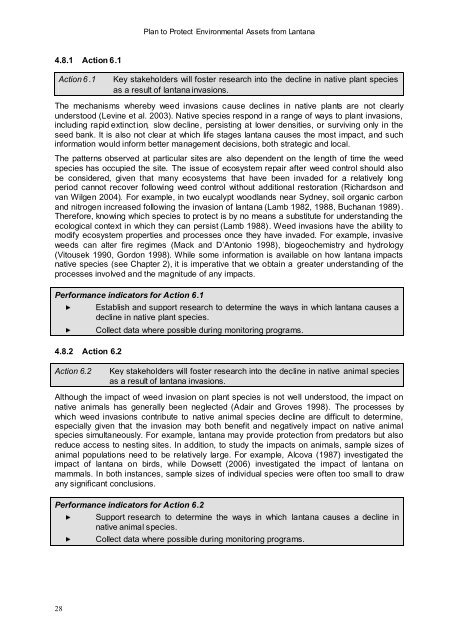Plan to Protect Environmental Assets from Lantana - Weeds Australia
Plan to Protect Environmental Assets from Lantana - Weeds Australia
Plan to Protect Environmental Assets from Lantana - Weeds Australia
You also want an ePaper? Increase the reach of your titles
YUMPU automatically turns print PDFs into web optimized ePapers that Google loves.
<strong>Plan</strong> <strong>to</strong> <strong>Protect</strong> <strong>Environmental</strong> <strong>Assets</strong> <strong>from</strong> <strong>Lantana</strong><br />
4.8.1 Action 6.1<br />
Action6 .1<br />
Key stakeholders will foster research in<strong>to</strong> the decline in native plant species<br />
as a result of lantana invasions.<br />
The mechanisms whereby weed invasions cause declines in native plants are not clearly<br />
unders<strong>to</strong>od (Levine et al. 2003). Native species respond in a range of ways <strong>to</strong> plant invasions,<br />
including rapid extinct ion, slow decline, persisting at lower densities, or surviving only in the<br />
seed bank. It is also not clear at which life stages lantana causes the most impact, and such<br />
information would inform better management decisions, both strategic and local.<br />
The patterns observed at particular sites are also dependent on the length of time the weed<br />
species has occupied the site. The issue of ecosystem repair after weed control should also<br />
be considered, given that many ecosystems that have been invaded for a relatively long<br />
period cannot recover following weed control without additional res<strong>to</strong>ration (Richardson and<br />
van Wilgen 2004). For example, in two eucalypt woodlands near Sydney, soil organic carbon<br />
and nitrogen increased following the invasion of lantana (Lamb 1982, 1988, Buchanan 1989).<br />
Therefore, knowing which species <strong>to</strong> protect is by no means a substitute for understanding the<br />
ecological context in which they can persist (Lamb 1988). Weed invasions have the ability <strong>to</strong><br />
modify ecosystem properties and processes once they have invaded. For example, invasive<br />
weeds can alter fire regimes (Mack and D’An<strong>to</strong>nio 1998), biogeochemistry and hydrology<br />
(Vi<strong>to</strong>usek 1990, Gordon 1998). While some information is available on how lantana impacts<br />
native species (see Chapter 2), it is imperative that we obtain a greater understanding of the<br />
processes involved and the magnitude of any impacts.<br />
Performance indica<strong>to</strong>rs for Action 6.1<br />
4.8.2 Action 6.2<br />
Establish and support research <strong>to</strong> determine the ways in which lantana causes a<br />
decline in native plant species.<br />
Collect data where possible during moni<strong>to</strong>ring programs.<br />
Action 6.2<br />
Key stakeholders will foster research in<strong>to</strong> the decline in native animal species<br />
as a result of lantana invasions.<br />
Although the impact of weed invasion on plant species is not well unders<strong>to</strong>od, the impact on<br />
native animals has generally been neglected (Adair and Groves 1998). The processes by<br />
which weed invasions contribute <strong>to</strong> native animal species decline are difficult <strong>to</strong> determine,<br />
especially given that the invasion may both benefit and negatively impact on native animal<br />
species simultaneously. For example, lantana may provide protection <strong>from</strong> preda<strong>to</strong>rs but also<br />
reduce access <strong>to</strong> nesting sites. In addition, <strong>to</strong> study the impacts on animals, sample sizes of<br />
animal populations need <strong>to</strong> be relatively large. For example, Alcova (1987) investigated the<br />
impact of lantana on birds, while Dowsett (2006) investigated the impact of lantana on<br />
mammals. In both instances, sample sizes of individual species were often <strong>to</strong>o small <strong>to</strong> draw<br />
any significant conclusions.<br />
Performance indica<strong>to</strong>rs for Action 6.2<br />
Support research <strong>to</strong> determine the ways in which lantana causes a decline in<br />
native animal species.<br />
Collect data where possible during moni<strong>to</strong>ring programs.<br />
28

















